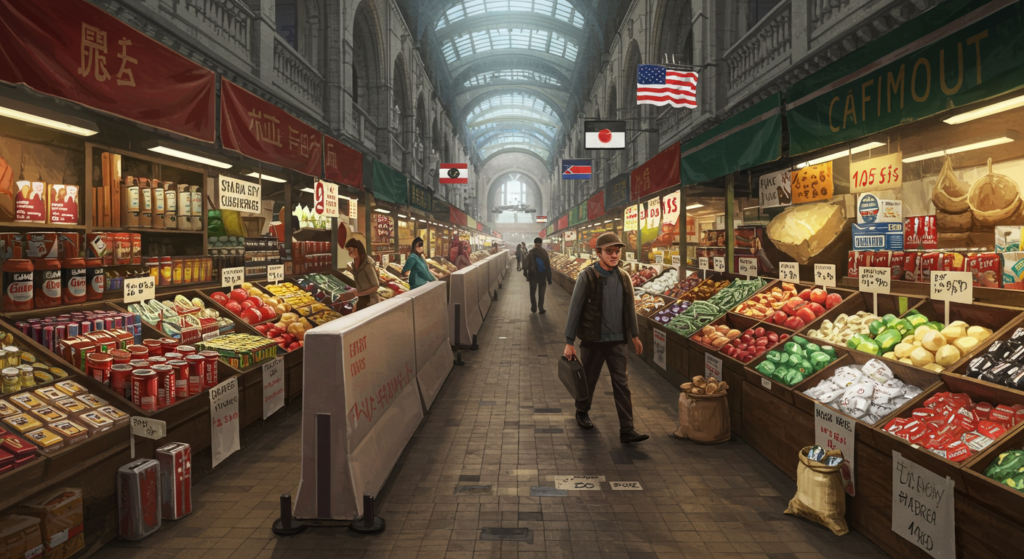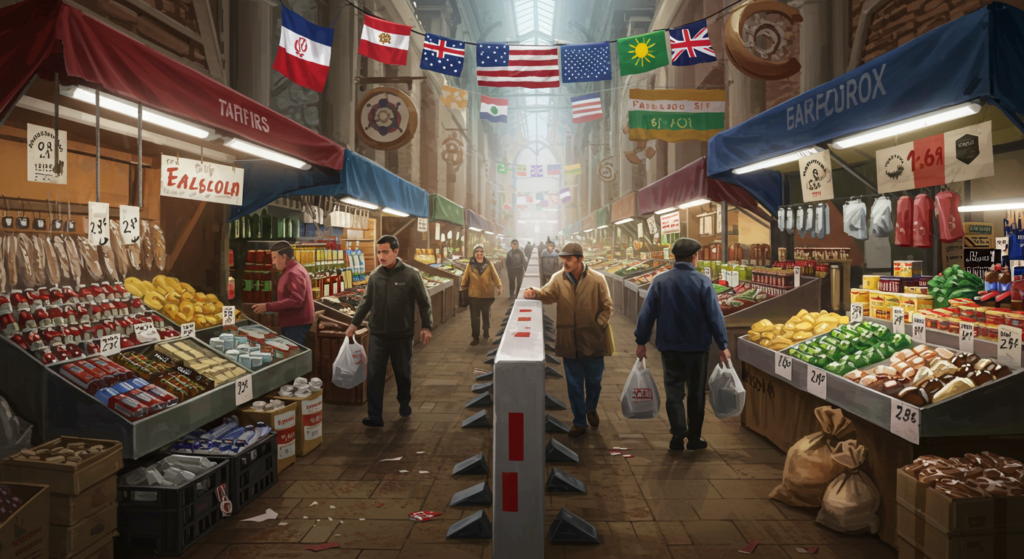What is a tariff and how does it work? This essential question opens the door to understanding a critical tool in international trade. A tariff is a government-imposed tax on imported goods, designed to regulate trade and protect domestic industries. By making foreign products more expensive, tariffs encourage consumers to support local businesses, ultimately benefiting the economy. Imagine your favorite imported snack costing more than a gourmet meal; this scenario illustrates how tariffs can shift consumer preferences towards local options.
Tariffs do more than protect domestic industries—they also generate revenue for governments, funding public services and infrastructure. But imposing tariffs can trigger trade disputes, leading to retaliatory measures and escalating into trade wars. These conflicts often result in higher consumer prices, reduced trade, and strained international relations.
While tariffs may offer short-term advantages to certain industries, they can disrupt global supply chains, increase costs, and limit consumer choice. Protectionist policies may also isolate countries from global markets, shifting economic power toward those that embrace open trade.
In this article, we’ll unpack what tariffs are, how they work, and their broader impact on both domestic economies and global relations. From import duties to recent trade wars—like the Trump-era tariffs and their effect on US-China trade—we’ll explore how these policies influence everything from the price of imported goods to local job markets.
Whether you’re a business owner, a consumer, or simply curious about international trade, understanding tariffs is key to making sense of our interconnected global economy.
Understanding What Is A Tariff And How Does It Work To Protect Our Economy
A tariff is a government-imposed tax on imported goods designed to regulate trade and protect domestic industries. This tax influences consumer behavior by making imported products more expensive, thereby encouraging consumers to support local businesses. Consequently, this shift can have a positive impact on the economy. Tariffs can increase the cost of imported goods, potentially making them more expensive than their domestic counterparts, which may influence consumer purchasing decisions.
Tariffs can be categorized into several types, each serving distinct functions in trade regulation. Import duties specifically target foreign goods entering a country, while customs duties apply to all goods crossing borders. Additionally, specific tariffs impose a fixed fee per unit of imported goods, complicating the landscape of international trade. Understanding these nuances is vital for businesses that must navigate tariff regulations to remain competitive.
One of the key functions of tariffs is to elevate the prices of foreign products, which supports local market growth. By raising prices on foreign products, tariffs protect local industries from international competition. However, this protection can sometimes burden consumers with higher costs.
Given that tariffs significantly impact market dynamics and consumer choices, they can lead to higher prices, reducing purchasing power. This reduction can have broader implications for economic growth and consumer confidence. Furthermore, tariffs can create diplomatic tensions between nations, as seen in recent trade disputes involving the Trump tariffs and China tariffs.
The balancing act of tariffs is essential for maintaining a healthy economic environment that fosters growth while protecting domestic interests. Grasping the effects of tariffs is vital for both businesses and consumers, as these policies can alter market strategies and consumer preferences. Understanding tariffs is crucial for navigating the complexities of trade, as they shape trade policies and influence market behavior, affecting everything from prices to supply chains.
How Tariffs are secretly altering your shopping choices today
Imagine a small business owner facing higher prices for imported materials due to new tariffs. This scenario highlights the real-world implications of tariff policies on business operations and consumer experiences. Tariffs significantly influence international trade dynamics, affecting prices, consumer choices, and diplomatic relations between countries.
Tariffs can lead to trade wars, as seen with the Trump tariffs on China, which aimed to reduce the trade deficit and protect American jobs. Countries often retaliate with their own tariffs, escalating tensions and complicating international trade. Consequently, the impact of tariffs can ripple through economies, affecting everything from consumer prices to employment rates.
Tariff rates vary significantly based on the product and the country of origin, influencing the overall cost of imports and creating challenges for businesses that rely on specific materials. For instance, some goods may face higher import duties than others, complicating the cost structure for businesses. This variation necessitates strategic planning and adaptability in response to changing trade regulations.
In the long run, tariffs can affect prices, consumer choices, and international relations, as countries may retaliate, leading to a cycle of escalating trade barriers. Crafting effective tariff policies requires careful consideration, as this cycle can create an unpredictable trading environment that complicates international business operations. As countries impose tariffs, they may inadvertently harm their own economies by raising prices for consumers. Hence, governments must carefully evaluate the implications of tariffs on both domestic and international fronts.
By and large, effective tariff policies require thorough analysis of the broader economic landscape. Such analysis is crucial for policymakers to ensure that tariffs achieve their intended purpose without causing unintended harm to the economy. In conclusion, understanding the complexities of tariffs is essential for navigating the challenges of global trade.

Understanding What Is A Tariff And How Does It Work To Protect Our Economy
Did you know that tariffs can feel like a hidden tax on your everyday purchases? These government-imposed taxes on imported goods not only influence prices but also shape our shopping experiences. Understanding tariffs is crucial for everyone, not just economists or business owners, as they impact all consumers. As we delve into the intricacies of tariffs, let’s explore how these taxes affect our economy and our wallets.
Tariffs serve as powerful tools that governments wield to influence market dynamics. When a country imposes tariffs on imports, it alters the prices we encounter at the checkout counter and can even limit the variety of products available. Recent US-China tariffs exemplify this, stirring trade tensions while simultaneously affecting the prices of everyday goods. By grasping how tariffs function, we can navigate these changes and make informed purchasing decisions, keeping the bigger picture in mind.
Equally important is recognizing that tariffs can spark trade wars, creating a ripple effect of uncertainty in the market. When countries retaliate against each other’s import duties, it resembles a game of economic chess, often leaving consumers in a precarious position. While tariffs aim to protect local industries and generate government revenue, they can also disrupt our shopping habits and complicate product availability. Striking the right balance between safeguarding domestic interests and promoting free trade is essential for policymakers, impacting us all.
In conclusion, the implications of tariffs extend far beyond mere financial figures. They influence our buying decisions and shape international relationships. Tariffs are not just burdensome taxes; they are strategic instruments that can lead to significant shifts in the global economy. By understanding their purpose and impact, we can engage in meaningful discussions about trade policy and its effects on our lives, making us more informed participants in the world of international trade and economics.
Listen to an AI-Generated Podcast of this Blog
Unveiling the Hidden Impact of Tariffs on Your Wallet
Here’s a random fact about tariffs that might surprise you. Tariffs significantly influence the prices of imported goods. Whenever a government imposes tariffs, it raises the cost of imports. This increase often leads to higher prices for consumers at the store. Specifically, the Trump tariffs on China created a ripple effect in the market. As a matter of fact, these tariffs affected various products, from electronics to food items. In conclusion, tariffs can feel like hidden taxes on everyday purchases. Import duties and customs duties play a crucial role in shaping trade dynamics. Point often overlooked is how these tariffs can lead to trade wars. Last but not least, understanding tariffs helps consumers make informed choices.
FAQs
What is a tariff and how does it work in international trade?
A tariff is a government-imposed tax on imported goods. It regulates trade and protects domestic industries.
How do tariffs affect consumer prices?
Tariffs make foreign products more expensive, leading to higher prices for consumers. This encourages support for local businesses.
Can you explain the different types of tariffs?
Tariffs include import duties, customs duties, and specific tariffs. Each serves distinct functions in trade regulation.
What are the implications of the Trump tariffs on China?
The Trump administration implemented tariffs with the stated goals of reducing the trade deficit and protecting American jobs. However, these measures escalated trade tensions with China, leading to retaliatory tariffs and a complex trade environment.
How do tariffs influence consumer choices?
Tariffs can limit product variety and raise prices, prompting consumers to choose local options over imported goods.
What happens during a trade war?
In a trade war, countries retaliate with tariffs, escalating tensions and complicating international trade dynamics.
How do tariffs impact global supply chains?
Tariffs disrupt global supply chains, creating inefficiencies and increased costs that businesses often pass on to consumers.
Why are tariffs considered a hidden tax?
Tariffs act as a hidden tax on imported goods, influencing prices and shopping experiences without direct consumer awareness.
What role do tariffs play in government revenue?
Tariffs generate revenue for governments, which can be allocated to public services and infrastructure projects.
How can understanding tariffs benefit consumers?
Understanding tariffs helps consumers make informed purchasing decisions and navigate the complexities of international trade.
ORDER YOUR SEO OPTIMIZED BLOG TODAY
If you’ve landed on this page while searching for SEO marketing — well, that’s the proof right there. You found us through SEO. In fact, we haven’t used social media. We haven’t run paid ads either. Instead, we’ve relied solely on our own articles. So, why not let it work for you too? Go ahead — order your blog with us.
Each one is generated using our custom-built AI prompt system. From there, it’s enhanced further with carefully crafted prompts to improve clarity, structure, and keyword focus.






